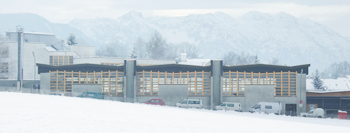Impuls Bildanalyse GmbH has carried out a project monitoring the roof structure of a gymnasium near the German alps, where heavy loads of snow may affect the safety of the building. The project has been jointly carried out with the Technical University Munich and the University of Applied Sciences Karlsruhe. The topic came into the spotlight with the collapse of the roof of the ice rink in Bad Reichenhall in the winter of 2005/2006.
Also, snow load standards have been changed recently with DIN 1055-5:2005-07, which has been obligatory since 2007. This means that many buildings are no longer safe with regards to this norm. Such a building can still be operated on the right of continuity, but as soon as significant modifications are undertaken, the building has to be adapted to the up-to-date standard. Normally, interventions in the building structure are unavoidable in this case, which often incurs technical difficulties and very high costs. At this point, monitoring systems offer an alternative. As far as national law allows, monitoring can to a certain extend replace the reinforcement of the building structure.
There are a number of different systems for measuring structural deformations. Robotic tachymetry is a particularly successful method employed in many areas of structural engineering. Simple light barriers and laser distance gauges are sometimes used, as well. Some of them, as in the case of robotic tachymetry, are extremely costly. Other systems are not suitable for continuous measuring tasks or are difficult to set up in a building when it is in operation. Monitoring using cameras can provide a cost-effective and accurate solution.
Deformations are measured on the basis of digital image processing. The required camera unit comprises a camera with an integrated processor (K). The “smart” camera functions in the infrared zone and captures images covering an area of about 300 x 400 mm in the middle of the main beam. Its purpose is to record any vertical or horizontal shifting of the measuring points (M), which are clearly marked by infrared LED’s. To reduce the influence of imperfections in the assembly work and any possible operating inaccuracies, the measuring points always relate to a fixed point of reference (R), which is mounted within the camera’s line of vision but outside the movable roof structure area. Since the photos are taken by the camera within the infrared range and the camera is also equipped with a daylight filter, the quality of the images is not affected by lighting conditions in the gym. The camera can be operated with a fixed aperture during the daytime and the night-time. The size of the aperture only has to be aligned to the brightness of the LED’s. The images captured by the smart camera are capable of detecting movements at the points marked by the LED’s, down to a millimeter. The picture frequency and data storage rate are regulated by the results: i.e. the number of images required per unit of time depends on the speed and the extent of the sagging of the support beam.
More information: 111014-kh-rp-kurzbericht-monitoring

